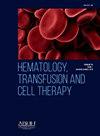PSMA PET/CT 在腺样囊性癌评估中的适用性
IF 1.8
Q3 HEMATOLOGY
引用次数: 0
摘要
腺样囊性癌(adenoid Cystic Carcinoma, ACC)是一种罕见的侵袭性肿瘤,其特点是生长缓慢、缓慢、高复发、高转移率,难以早期发现,18F-FDG PET/CT成像对其诊断、分期和监测至关重要。在过去的十年中,18F-PSMA PET/CT治疗前列腺癌的前景很好,因此在ACC中使用18-Fluor(诊断)和177-Lutetium(治疗)来评估PSMA靶标,ACC细胞过度表达这种表面抗原。由于这是一项新发现,需要进一步的研究来评估18F-PSMA PET/CT在ACC病例中预测预后和评估治疗反应的应用。与18F-FDG PET/CT相比,18F-PSMA PET/CT是否可以用作ACC的诊断技术,因此,标记PSMA是否可能成为这种癌症的治疗资源?目的评价18F-PSMA PET/CT与18F-FDG PET/CT在ACC治疗中的适用性。材料与方法5例确诊为ACC的患者(A、B、C、D、E)分别接受18F-FDG PET/CT和18F-PSMA PET/CT检查(除2例外,间隔24小时),并使用两种示踪剂评估病变的摄取情况。初步结果患者A仅在颈部淋巴结18F-FDG PET/CT表现为高代谢;B在原发病变部位、颈部淋巴结和肺部的18F-FDG PET/CT上表现出明显较高的摄取(检查和阿霉素治疗后46天);C和D对两种示踪剂的摄取相似:C在L5椎体和肺,D在肺;E表现出两种示踪剂的摄取,在有18F-FDG的颈部淋巴结,提示炎症,在有18F-PSMA的肺部。初步数据表明,ACC中两种示踪剂的摄取模式相似,但存在差异,需要进一步研究。结论本研究强调了18F-PSMA PET/CT在ACC诊断管理中的潜在应用,扩大了其可能的治疗应用。本文章由计算机程序翻译,如有差异,请以英文原文为准。
APPLICABILITY OF PSMA PET/CT IN THE EVALUATION OF ADENOID CYSTIC CARCINOMA
Introduction/Justification: Introduction
Adenoid Cystic Carcinoma (ACC) is a rare and aggressive tumor characterized by slow and indolent growth, high recurrence, high metastasis rates, and challenging early detection, and 18F-FDG PET/CT imaging has become essential for diagnosis, staging, and monitoring of it. In the last decade, the promising theranostic approach of 18F-PSMA PET/CT for prostate carcinoma has led to the evaluation of PSMA target with 18-Fluor (diagnostic) and 177-Lutetium (therapeutic) in ACC, whose cells overexpress this surface antigen.
Justification
As it is a recent discovery, further studies are needed to evaluate the use of 18F-PSMA PET/CT to predict the prognosis and assess therapy response in ACC cases.
Research Question
Could 18F-PSMA PET/CT, compared to 18F-FDG PET/CT, be used as a diagnostic technique for ACC and, as a consequence, labeled PSMA be potentially a therapeutic resource for this cancer?
Objective
Evaluate the applicability of 18F-PSMA PET/CT compared to 18F-FDG PET/CT in the management of ACC.
Materials and Methods
Five patients (A, B, C, D, and E) diagnosed with ACC underwent 18F-FDG PET/CT and 18F-PSMA PET/CT (24-hour intervals, except by two cases), and the lesions uptakes were evaluated with both radiotracers.
Preliminary Results
Patient A showed hypermetabolism only for 18F-FDG PET/CT at cervical lymph nodes; B exhibited an uptake substantially higher on 18F-FDG PET/CT at the primary lesion site, cervical lymph nodes, and lung (46 days between the exams and after treatment with doxorubicin); C and D showed similar uptake on both tracers: C at L5 vertebra and lung, and D at lung; E exhibited uptake of both tracers, in cervical lymph nodes with 18F-FDG, suggesting inflammation, and in the lung with 18F-PSMA.
Discussion
Preliminary data suggest similar uptake patterns for both tracers in ACC, with variations warranting further investigation.
Conclusion
The study highlights the potential use of 18F-PSMA PET/CT in the diagnostic management of ACC, expanding its possible therapeutic application.
求助全文
通过发布文献求助,成功后即可免费获取论文全文。
去求助
来源期刊

Hematology, Transfusion and Cell Therapy
Multiple-
CiteScore
2.40
自引率
4.80%
发文量
1419
审稿时长
30 weeks
 求助内容:
求助内容: 应助结果提醒方式:
应助结果提醒方式:


